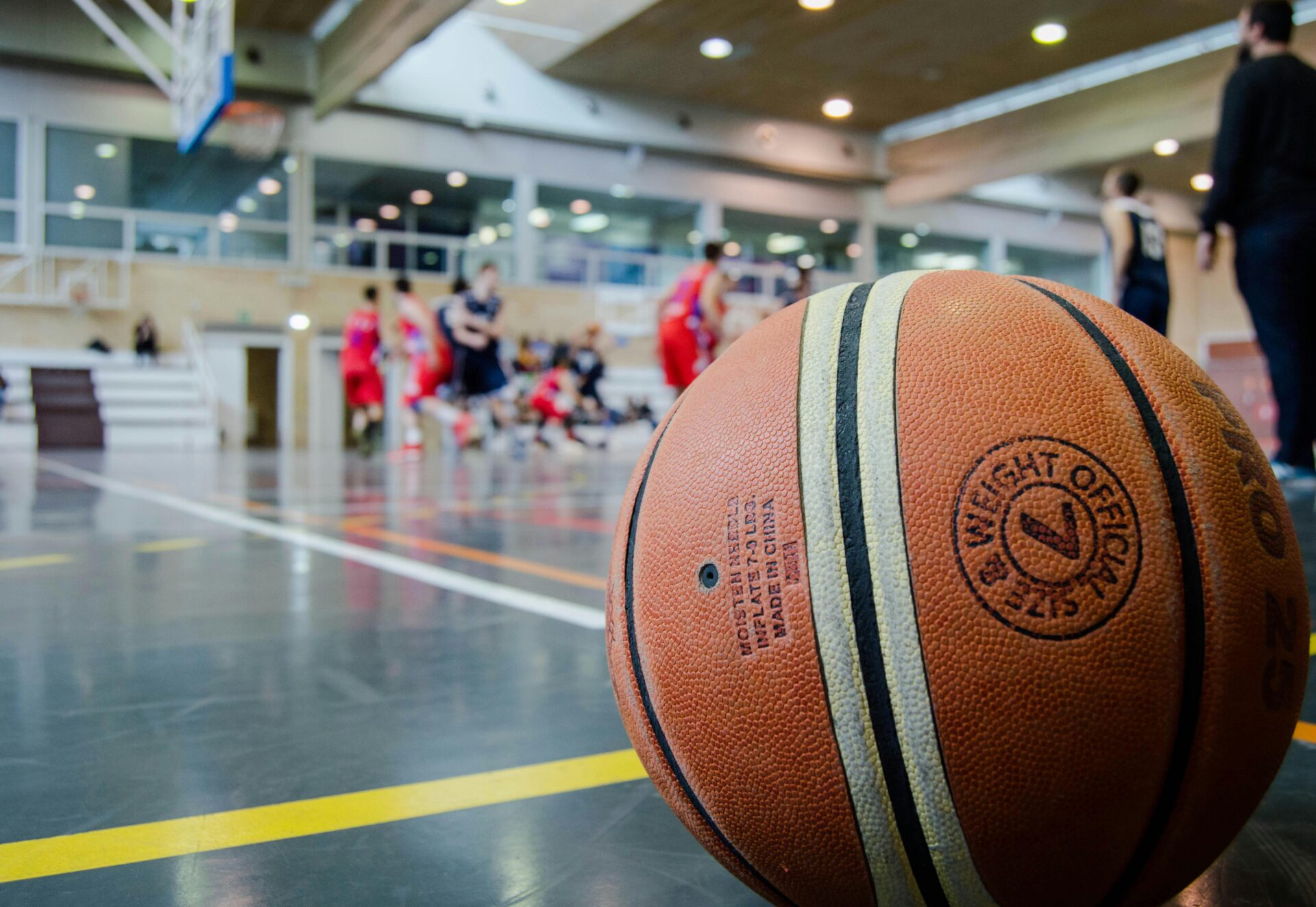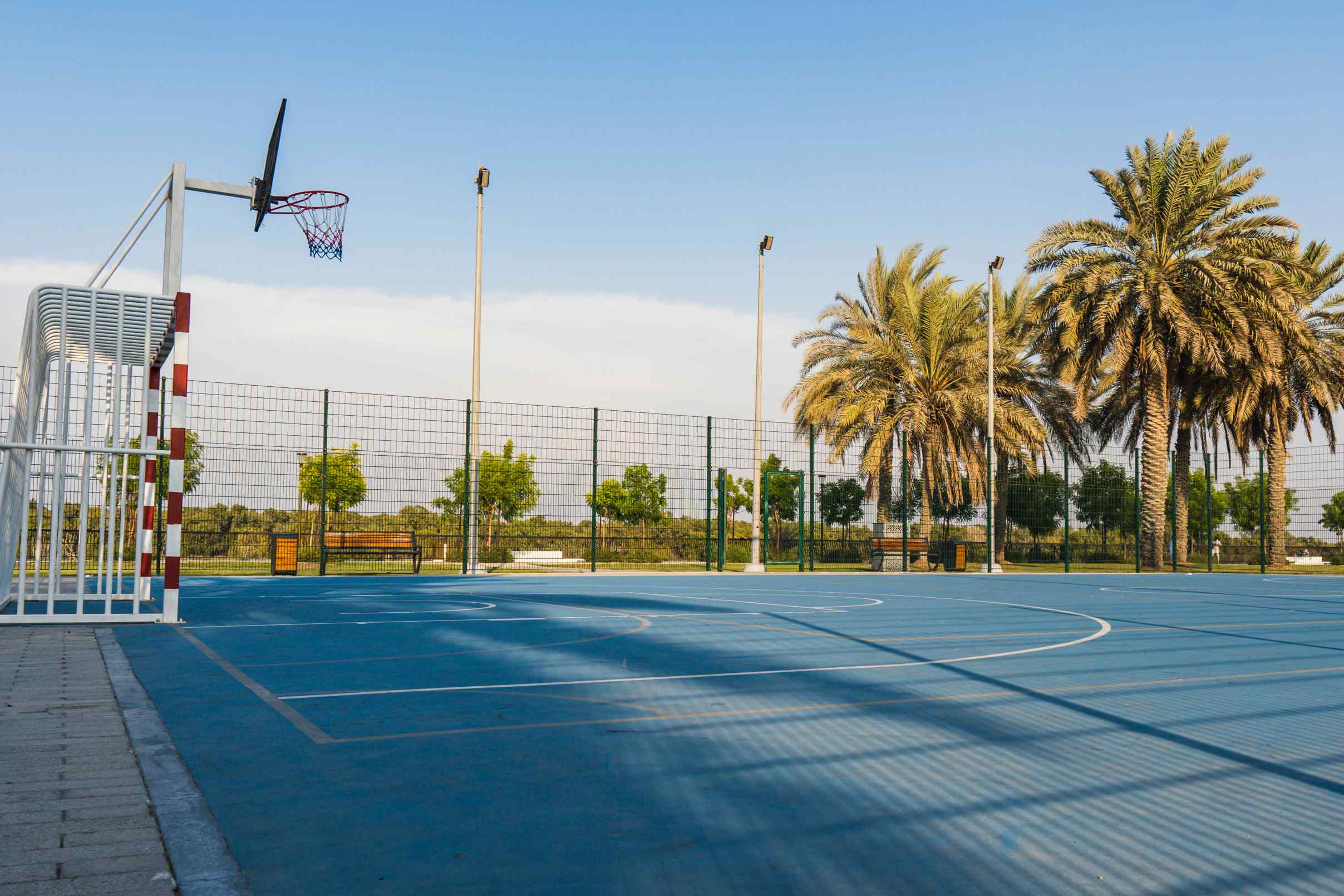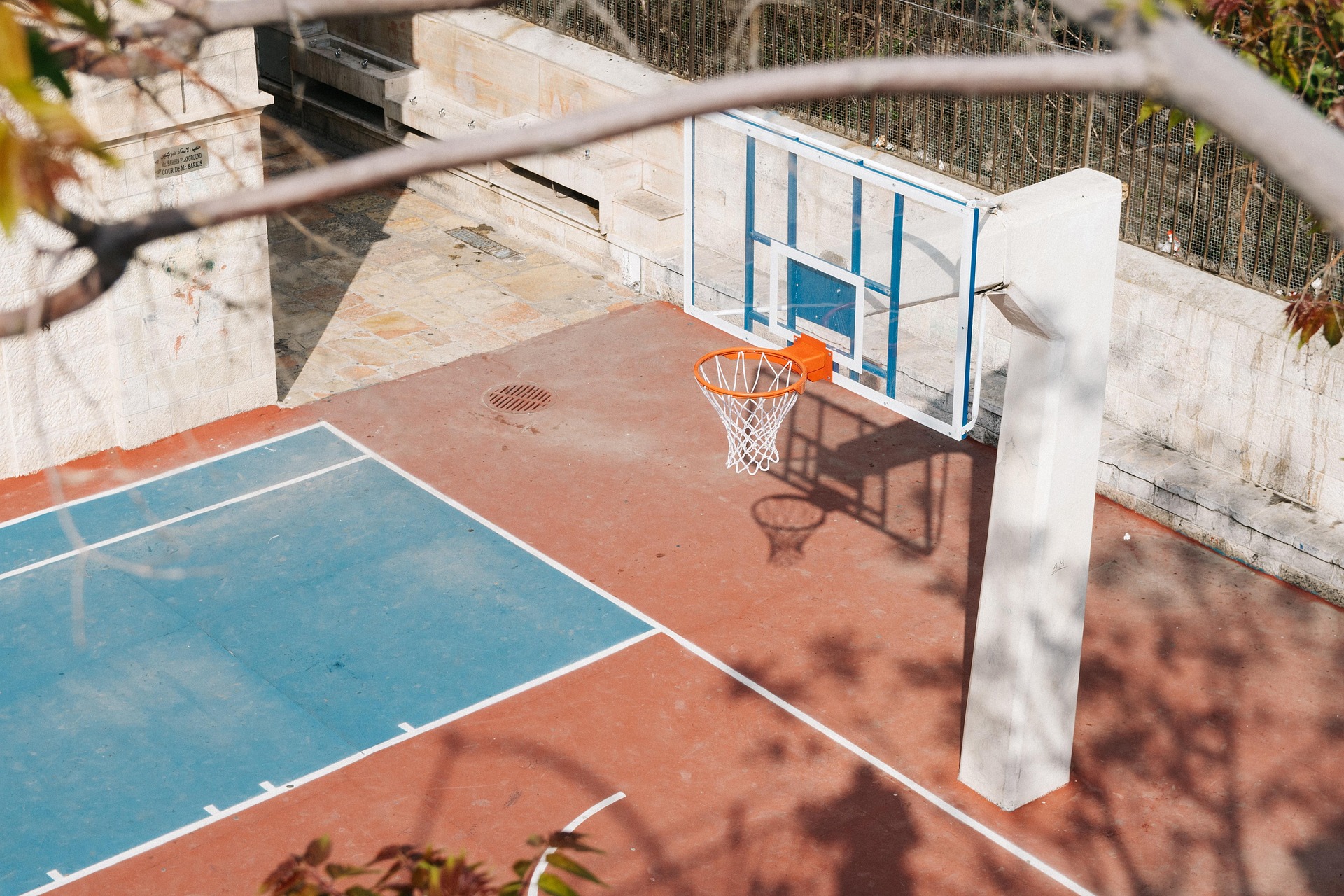The volleyball game is one of the most popular team sports played worldwide because of its exciting action and competitive spirit. If you’re new to the sport or looking to brush up on your knowledge, one basic question you may have is, How Many Players on a Volleyball Team?
It is important to note that depending on the level of play and type of volleyball that is being played on a volleyball team, there can be a wide range of players on the team.
A team consists six of players with specific roles, such as the libero, outside hitter, opposite hitter, middle blocker, and setter. Substitutions can be made for specialized positions like defensive specialists or serving specialists.
In this article, we will explore the different variations of the sport and break down how many players are typically on a volleyball team at various levels of competition.
Whether you’re a beginner or an experienced player, continue reading to understand better how many players volleyball on a team is structured.
let’s start
Basic Information About Volleyball Players.
Volleyball is a popular team sport played across the world. The number of players on the court and their roles are crucial aspects of the game. Here, we will explore the basic structure of a volleyball team and how it can vary depending on the level of play.

1. The Basic Team Composition
A typical volleyball team is made up of six players who are split into two rows: the front row and the back row, each with three players. This formation allows for a balanced distribution of roles and responsibilities among the players during the game.
2. Starting the Game with Four Players
The average volleyball team has six players; however, a volleyball match can usually start with as few as four players on the court. It is essential that a team has at least six players when it comes to official games so as to ensure that the match is fair and competitive.
3. Mixed-Gender Games
In mixed-gender games, teams can be formed in different ways. They can consist of three men and three women, four men and two women, or four women and two men. Another option is a team with two males and two females. These combinations of players bring diversity and excitement to the game.
4. Positions and Rotation
In volleyball, each player has a specific position on the court, and each player rotates that position when his or her team is able to resume service in a clockwise direction. The three players in the front row can jump, spike, and block near the net.
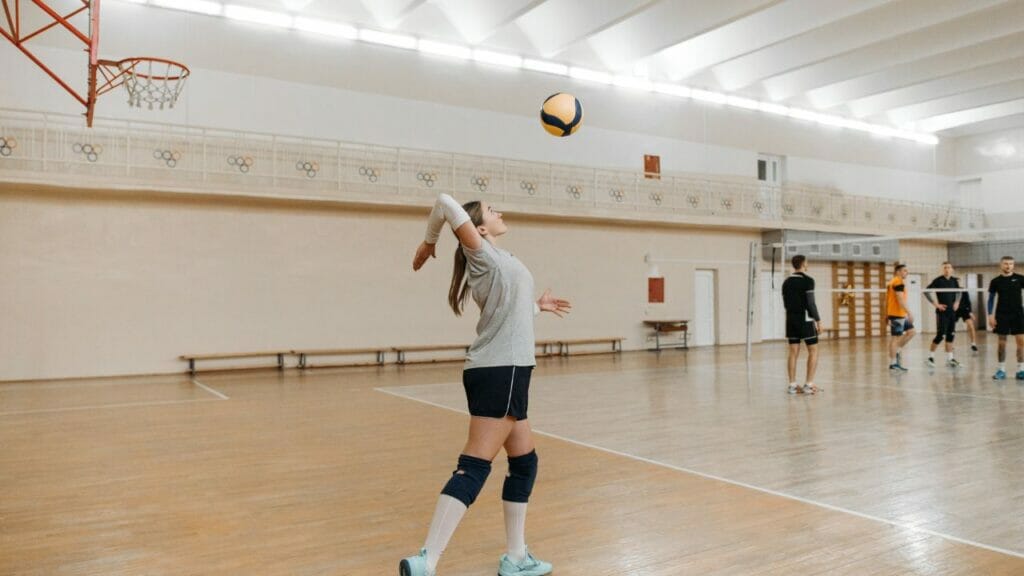
The players in the backcourt can only attempt to throw the ball over the net if they jump from behind the attack line, which is also called the three-meter line that separates the front and back halves of the court.
5. Team Line-Up
A well-organized lineup is crucial to a volleyball team’s success in the game, as it helps them to perform better in the contest. This lineup typically includes a setter, two center blockers, two receiver hitters, and a universal spiker.
Each player’s role is vital for effective gameplay, and the team’s overall success greatly depends on how well they perform together.
6. Substitutions and Players on the Court
Substitutions are permitted during a volleyball game, allowing players to be interchanged throughout the match. Maintaining the number of players on the court within the allowed limit is crucial. Typically, the number of participants can be twelve to fourteen players at any given time.
7. The Introduction of the Libero
The FIVB introduced a new specialized role for volleyball players called the libero in 1998. This specialized player wears a unique-colored jersey and can substitute for any backcourt player.
With the libero’s addition to the backcourt defense, a new dimension has been added to backcourt defense, improving team reception, prolonging rallies, and providing an important role for shorter players.
8. Varying Number of Players
With the introduction of the libero, the number of players on a volleyball court is no longer fixed. Depending on the level of the game and the team’s strategy, some teams may choose to include a libero in their lineup, while others may opt not. This means there can be anywhere from six to seven players on the court at any moment.
The Standard Number of Players in a Volleyball Team
Volleyball is a dynamic and exciting sport that can be played in different team sizes depending on the level of competition and the format of the game.

This section will explore the various team sizes commonly used in volleyball, ranging from six players in regulation matches to smaller teams of four and two players in specific contexts. Let’s see how many players are on a volleyball team.
1. Regulation Team Size
A volleyball team usually has six players on the court in regulation matches. However, teams often have more than six players on their roster, which allows for substitutions in case of injury, suspension, or tactical changes.
In professional volleyball tournaments like the Olympics, teams can have up to twelve players on their roster. Beach volleyball, on the other hand, typically has smaller team sizes. The entire team roster consists of just two players. In some cases, beach volleyball teams may have four players, including substitutes.
2. Six Players On Each Team
In regulation court volleyball, the standard format between professional athletes is to play with a team of six players on the court at the same time. This team size is necessary to effectively fill all positions in volleyball.
The coordination and understanding of each player’s role are crucial in this team format, which is also commonly used in beach volleyball.
3. Four Players On Each Team
Playing in groups of four is more typical in casual settings and competitions. Although it is not as common among professional volleyball players, it is still played in mixed-gender leagues. The rules do not differ significantly from playing in larger teams of six. Teams of four often experiment with various role rotations, such as using a diamond or square formation or playing with more flexible positions. Effective communication and teamwork are still crucial, but the smaller team size can make blocking more challenging and increase the need for quick recovery.
4. Two Players On Each Team
Playing in pairs is the most popular format in professional beach volleyball. It is a challenging style of play, as individuals must cover a larger portion of the court.
Those who enjoy playing in pairs often focus on improving their cardiovascular endurance to sustain continuous movement during matches. The gameplay in pairs differs significantly from larger team sizes.
With only two players, there is little margin for error, but coordination with one’s partner becomes more manageable. Trust between teammates is critical, and experienced players who have competed together in numerous matches tend to excel in this format.
In contrast, playing in pairs is uncommon for indoor court players, as the dynamics and strategies are vastly different from the standard six-player setup.
In short, Volleyball is a versatile sport that can be enjoyed in various team sizes, ranging from six players in regulation matches to smaller teams of four and two players in specific contexts.
Regardless of team size, volleyball offers players unique challenges and opportunities to showcase their skills, making it an engaging, inclusive sport for all ages.
What Is the Size of the Volleyball Roster at Different Levels?
Volleyball is an exhilarating team sport enjoyed at various levels of competition, from high school to international tournaments. The number of players on a volleyball roster can vary significantly based on the level of play and the specific competition.
In this section, we will explore the roster sizes commonly seen in volleyball at different levels, shedding light on the maximum number of players that can be brought to a game.
How Many Players Can You Bring to a Game?
At the highest level of elite volleyball, such as international tournaments, it is typical for teams to have 13, 14, or even 15 players present before a game. However, only 12 players are permitted to actively participate in the game. The extra players beyond the 12-player limit are present for moral support and are unable to join the game, even if there are injuries.
Roster Size for International Volleyball
In the uppermost tier of the sport, international volleyball teams typically have bigger rosters to accommodate different situations. It’s usual to have a total of 25 players on the roster.
Nevertheless, not all 25 players go on the team’s travels during international tournaments. Normally, teams travel with approximately 15 to 16 players and their supporting staff.
Roster Size for Professional Volleyball
The roster size in professional volleyball can differ depending on the league and level of competition. Generally, professional teams have rosters of 16 to 20 players, which is similar to college teams.
However, there may be variations in roster sizes for certain leagues or teams based on their specific requirements and regulations.
Roster Size for High School Volleyball
In high school volleyball, teams usually have 10 to 12 player’s rosters, although some teams may have up to 14 players. The final number of players selected for the roster depends on factors such as the level of competition and the coaching staff’s preferences.
Volleyball Roster Size in College
College volleyball teams usually have larger rosters than high school teams, with an average size of around 17 to 18 players. However, there are no rules on the maximum number of players allowed on a college-level roster.
In the past, some teams have even had rosters with up to 20 players. In short, the number of players on a volleyball team’s roster varies depending on the level of competition.
The Best Volleyball Sports Courts from VMKON
When it comes to sports courts, the choice of flooring plays a crucial role in ensuring superior performance and durability. With various types of synthetic courts available in the market, one brand that stands out is VMKON Sports Courts.
Renowned for their innovative and high-quality flooring solutions, VMKON Sports Courts offer a range of options for both indoor and outdoor courts. Here we will delve into the benefits and features of VMKON synthetic floors, highlighting why they are the ideal choice for your game’s court.
1. Easy Maintenance
One of the primary advantages of VMKON Volleyball Courts is their easy maintenance requirements. Unlike traditional courts, VMKON synthetic floors do not require extensive upkeep, saving you valuable time and effort.
These courts are designed to withstand heavy usage, making them suitable for high-traffic areas. With a VMKON Sports Court, you can focus on your game without worrying about constant cleaning and maintenance.
2. Durability
VMKON Sports Courts are built to last. The flooring materials used are of the highest quality, ensuring exceptional durability even under intense play.
These floors can withstand the impact of fast-paced sports and remain resilient, reducing the need for frequent repairs or replacements.
Whether basketball, tennis, Volleyball, or any other sport, interlocking floors tiles provide a reliable and long-lasting foundation for your game.
3. Versatility
VMKON Sports Courts offer a versatile range of options to suit various sporting activities. Whether it’s an indoor or outdoor volleyball court, VMKON synthetic interlocking sports flooring tiles are designed to meet the unique demands of each sport.
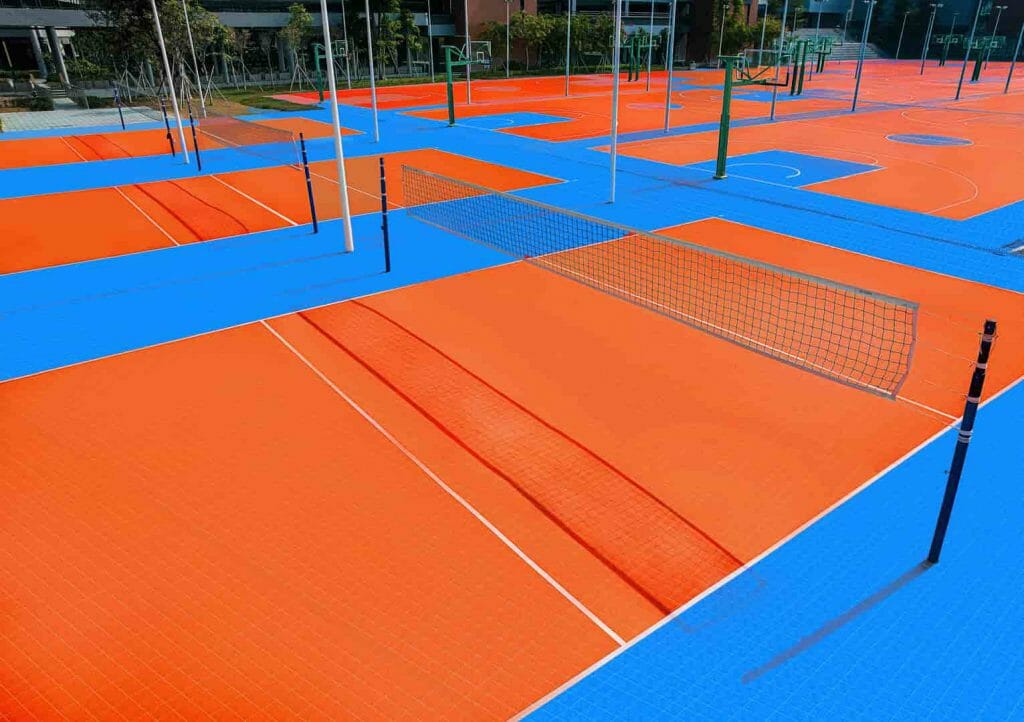
They provide excellent traction, allowing athletes to make quick movements and reduce the risk of slips and injuries. Moreover, VMKON Sports Courts can be customized to incorporate different color schemes and markings, adding a touch of personalization to your court.
4. Enhanced Performance
With VMKON Macwood flooring tiles, you can take your game to the next level. These courts are designed to provide optimal ball bounce, ensuring a consistent and predictable playing surface.

The high-quality materials used in VMKON Sports Courts offer excellent shock absorption, minimizing the strain on players’ joints and reducing the risk of injuries.
Whether you are a professional athlete or a recreational player, VMKON Macwood floors enhance your performance and create an ideal environment for competitive play.
5. Weather Resistance
VMKON Sports Courts are engineered to withstand various weather conditions. These synthetic floors maintain their performance and longevity, whether it’s extreme heat, heavy rain, or freezing temperatures.
Unlike natural surfaces that may become muddy or slippery in adverse weather, VMKON Sports Courts offer a reliable playing surface all year round. This weather-resistant feature makes VMKON synthetic floors a perfect choice for both indoor and outdoor courts.
Summary
The number of players on a volleyball team depends on the level of competition and the specific rules governing the game. In general, indoor volleyball teams consist of six players, with three players in the front row and three in the back row.
However, there are variations, such as four-player beach volleyball. It is important for teams to understand the specific requirements and regulations set forth by the governing body or league in which they are participating.
Ultimately, the number of players on a volleyball team is determined by the game format and the strategies employed by the team.
FAQs
Are there 12 players in volleyball?
No, in volleyball, there are typically six players on each team on the court at a time. This applies to indoor volleyball, which is the most common form of the sport. Each team consists of three front-row players and three back-row players.
How many substitutions are there in volleyball?
According to the FIVB (International Volleyball Federation) rules, each team is allowed a maximum of 6 substitutes in official competitions. This means that during a set, a team can make up to 6 substitutions, replacing players on the court with substitutes from the bench.
How many substitute players are there on the volleyball team?
In volleyball, teams typically have 6 substitute players on the bench. These players are available to be rotated into the game as substitutes when needed. The number of substitute players can vary depending on the competition rules and team preferences, but having 6 substitutes is a common practice.


